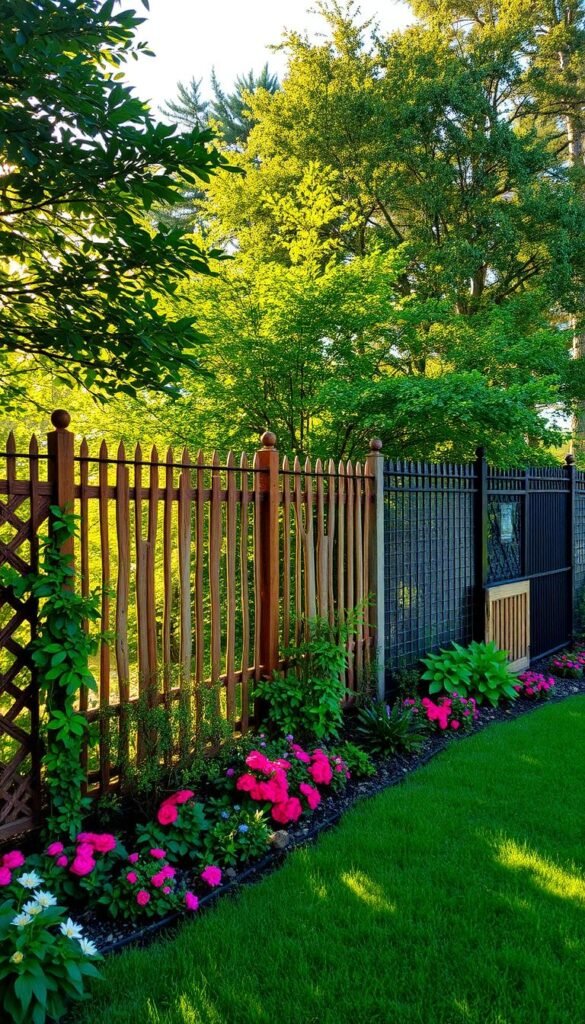Your backyard should feel like a personal retreat – a place where you can breathe deeply and enjoy nature without feeling watched. Privacy fencing does more than mark property lines. It crafts a secluded atmosphere that landscape architect Janice Parker calls “essential for modern outdoor living.”
Whether you’re sipping morning coffee or hosting weekend gatherings, the right barrier transforms your space. Costs vary widely, with basic DIY options starting under $10 per foot and custom designs reaching $150. This flexibility means every homeowner can find solutions matching their budget and style.
Modern barriers serve multiple roles beyond blocking views. They reduce noise, enhance security, and even support climbing plants. Materials range from classic wood to sleek composites, each offering distinct advantages. The best designs blend seamlessly with your home’s architecture while adding visual interest.
This guide explores creative approaches to balancing seclusion and aesthetics. You’ll discover how strategic placement and material choices can boost property value. We’ll also highlight innovative trends like living walls and eco-friendly options that redefine traditional boundaries.
Your outdoor space deserves to be both functional and beautiful. Let’s explore how to achieve that perfect mix of privacy and personality.
Elevate Your Garden’s Privacy with Stylish Fencing

Transform your outdoor area into a peaceful sanctuary where relaxation meets visual appeal. A thoughtfully designed privacy fence doesn’t just shield you from prying eyes—it crafts an atmosphere where every moment feels personal and intentional.
Benefits of a Private Outdoor Retreat
Imagine sipping coffee without worrying about neighbors’ glances or hosting friends in a space that feels truly yours. Strategic privacy screening hides distractions while revealing your landscape’s beauty piece by piece. Landscape architect Janice Parker notes this approach “builds curiosity, making even small yards feel expansive.”
Beyond seclusion, these structures soften street noise and create calm zones. Picture separate areas for dining, play, or quiet reflection—all flowing seamlessly yet maintaining their own purpose.
How a Well-Designed Fence Enhances Your Space
The right design acts like a picture frame for your cottagecore aesthetic, highlighting blooms instead of fences. Modern horizontal slats or lattice panels double as backdrops for climbing roses, blending function with artistry.
Materials matter too. Weather-resistant wood or composite boards ensure longevity while complementing your home’s character. Whether you prefer crisp lines or rustic charm, your barrier becomes part of the landscape—not just a divider.
Understanding the Role of Privacy Fences in Landscaping
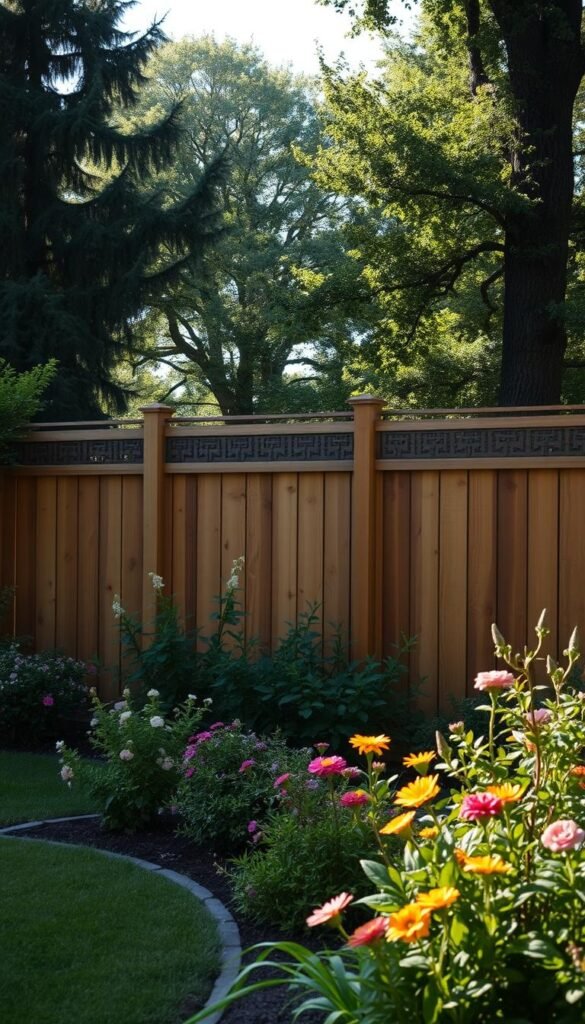
Your outdoor space needs boundaries that work smarter, not harder. While privacy fences create seclusion, their impact ripples through your entire landscape ecosystem. Landscape designer Jonathan Fargion notes:
“Barriers fragment habitats more than any other human-made feature. Every installation requires thoughtful balancing.”
More Than Just Boundaries
These structures multitask in surprising ways. They shield delicate hydrangeas from wind, keep pets safe, and define edges without harsh lines. The trick lies in choosing design elements that serve your needs while respecting nature.
| Practical Function | Ecological Consideration |
|---|---|
| Defines property lines | 2+ inch ground clearance |
| Blocks harsh winds | Native plant integration |
| Supports climbing vines | Permeable materials |
Size matters more than you think. A towering fence on a small lot feels imposing, while low profiles let sightlines flow. Match heights to your home’s architecture – ranch styles pair with horizontal lines, cottages with picket accents.
Leave room for wildlife corridors. That gap beneath panels lets frogs and beetles roam freely, maintaining your yard’s role in local ecosystems. Pair with native shrubs to soften edges and create natural transitions.
10 Unique Garden Fence Ideas for Privacy and Style
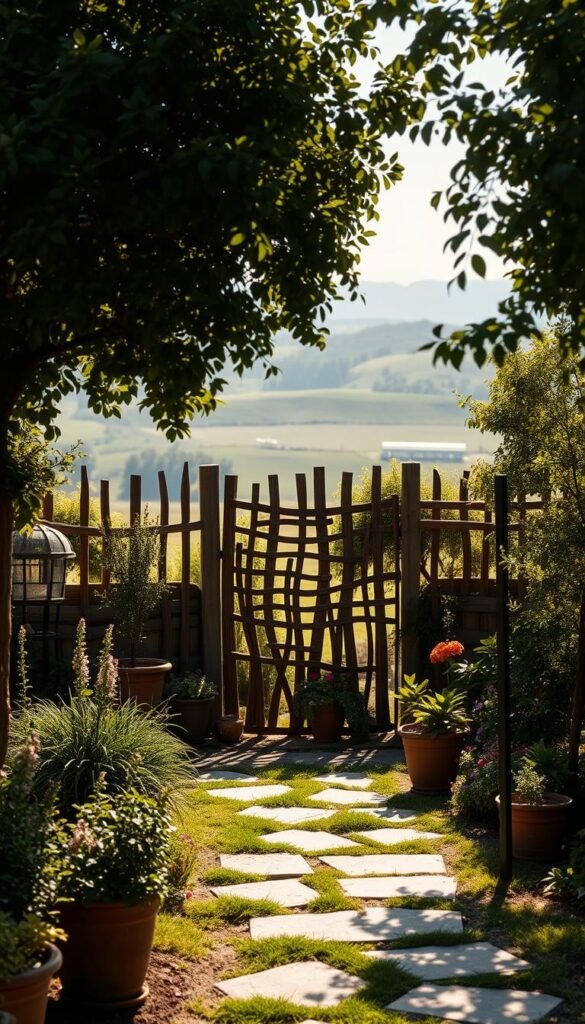
Crafting your outdoor sanctuary starts with smart design choices that marry form and function. Let’s dive into popular options transforming yards nationwide, balancing coverage and character without breaking the bank.
Stepped wood designs solve sloped terrain challenges beautifully. These tiered structures follow land contours, eliminating awkward gaps while maintaining consistent screening. At $25-40 per foot, they’re ideal for hillside properties needing adaptable solutions.
Bamboo trellises offer eco-friendly versatility. Priced around $20-35 per foot, these sustainable screens double as living walls when paired with climbing plants. Watch jasmine or clematis weave through the lattice, creating dynamic privacy that evolves with seasons.
Revamped picket fences prove classics can innovate. Taller versions (up to 6 feet) provide surprising seclusion while keeping that charming cottage feel. Pair with planter boxes or decorative post caps for personalized flair.
Horizontal slat designs deliver modern minimalism. Their clean lines and tight spacing ($25-45 per foot) create seamless barriers perfect for contemporary homes. Choose rich stains or bold paints to make these statement pieces pop.
Wrought iron brings timeless elegance to security needs. Though pricier ($30-60 per foot), its durability and intricate patterns justify the investment. Pro tip: Add planter hooks to soften metal’s starkness with trailing ivy or petunias.
Exploring Diverse Materials: Wood, Vinyl, Metal, and More
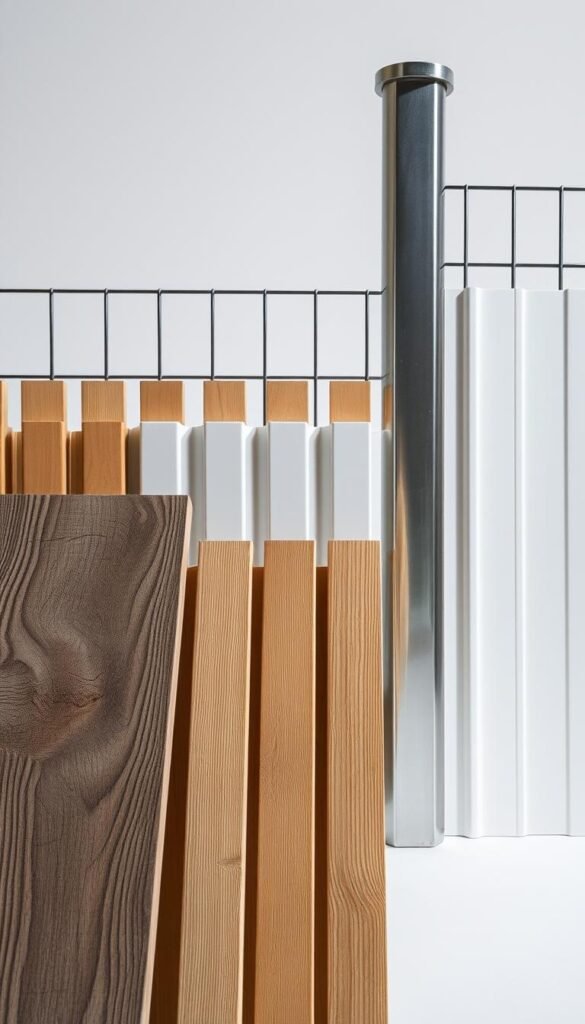
The materials you choose form the backbone of your outdoor sanctuary. Each option impacts your space’s look, durability, and upkeep. Let’s break down popular choices to help you balance aesthetics with practicality.
Timeless and Versatile: Wood Options
Wood remains the go-to for good reason. It’s easy to shape, repair, and adapt to any style. Cedar stands out with natural oils that resist rot – perfect for humid climates or rainy regions.
Premium varieties like Port Orford cedar take durability further. These dense grains shrug off insects and moisture damage. Want a custom look? Stain horizontal slats charcoal gray or paint vertical boards creamy white to match your budget garden projects.
Durable Alternatives: Vinyl and Metal
Modern vinyl mimics wood grain so convincingly you’ll do a double-take. Colors stay vibrant for decades without sanding or repainting. It’s ideal for busy homeowners wanting low-effort fencing.
Metal brings strength to the table. Aluminum offers lightweight security, while wrought iron delivers ornate designs. Both withstand harsh weather and last longer than many wood types. Add planter brackets to soften metallic surfaces with blooming vines.
| Material | Best For | Maintenance | Cost Range |
|---|---|---|---|
| Cedar | Custom styles | Annual sealing | $15-$30/ft |
| Vinyl | Low upkeep | Occasional wash | $20-$40/ft |
| Aluminum | Security | Rust checks | $25-$50/ft |
| Wrought Iron | Ornate designs | Paint touch-ups | $40-$80/ft |
Rustic and Traditional Wooden Fence Inspirations

Weather-worn planks whisper stories of decades past while framing your outdoor space. Reclaimed timber fencing offers unmatched authenticity, blending time-tested durability with organic charm. At $5-15 per linear foot, these materials let you create boundaries that feel lived-in yet purposeful.
Character and Warmth Through Natural Materials
Salvaged barn wood brings instant history to your property. Each split, knot, and nail hole becomes a design feature rather than a flaw. Landscape designer Mara Hoffman suggests: “Let the material guide your vision – its imperfections become your fence’s fingerprints.”
Unfinished cedar or pine develops a silvery-gray patina over time, harmonizing with wildflowers and mature trees. For a curated look, apply linseed oil to highlight grain patterns while slowing weathering. This approach keeps maintenance manageable despite wood’s natural vulnerabilities.
Mix plank widths and heights for casual appeal. Offset horizontal boards with vertical posts wrapped in climbing hydrangeas. Add wrought iron hinges or vintage lanterns to personalise the fence without overshadowing its rustic roots.
Budget-conscious homeowners love this style’s flexibility. Use mismatched boards from demolished barns or leftover construction lumber. The result? A one-of-a-kind barrier that costs less than prefab panels while radiating handcrafted charm.
Modern Designs: Horizontal Slats and Clean Lines
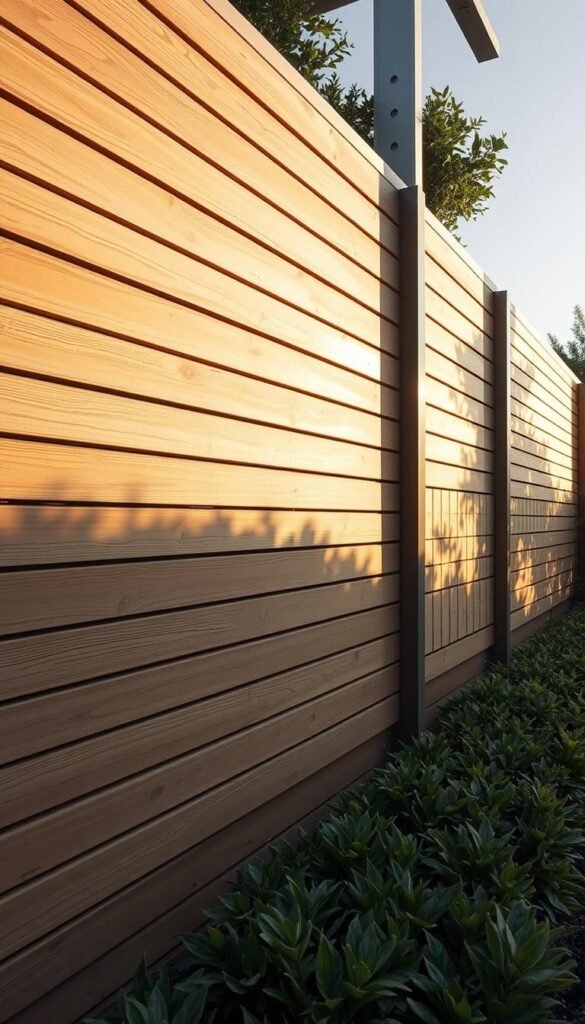
Clean, linear patterns redefine outdoor spaces with architectural precision. Horizontal slat designs turn functional barriers into striking design elements. Their streamlined appearance complements angular rooftops and minimalist gardens, creating harmony between your home and landscape.
These structures cleverly manipulate perception. By running boards parallel to the ground, they stretch sightlines to make narrow yards feel broader. The effect works wonders in urban settings where space feels tight. Choose 6-foot height for full coverage or staggered 4-foot panels to preserve light flow.
Customization shines here. Alternate board widths (4” to 8”) or mix wood with metal accents for texture. Composite materials offer fade-resistant grays and browns, while cedar accepts stains ranging from driftwood pale to espresso dark. Pro tip: Match your look to window trim colors for cohesive curb appeal.
Privacy meets practicality through smart spacing. Boards placed 1-2 inches apart block views but let breezes through. This balance prevents the “boxed-in” feel of solid walls. Pair with drought-tolerant grasses or sculptural succulents for low-maintenance edges that enhance the modern aesthetic.
Creative Trellis and Lattice Fence Ideas
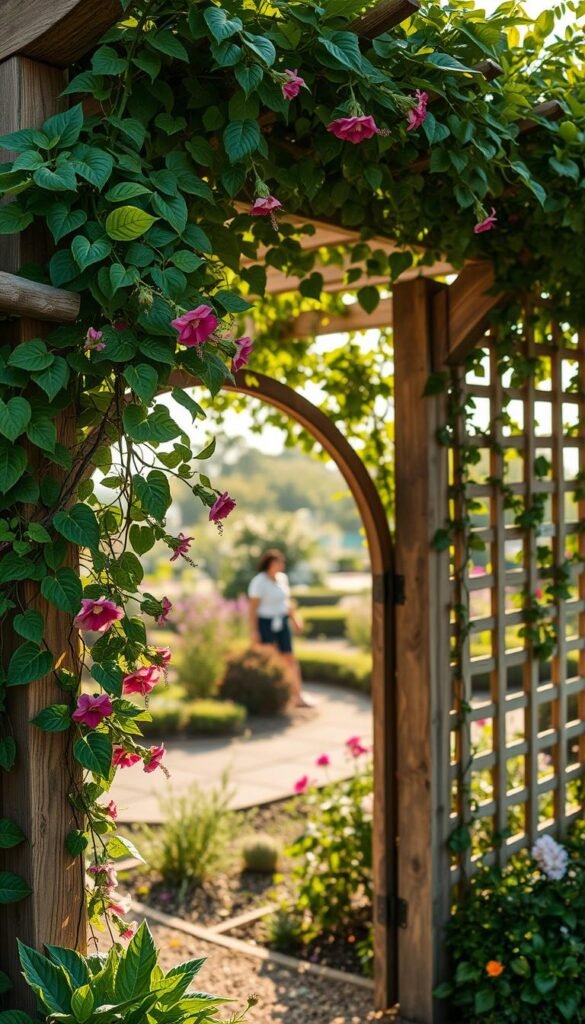
Turn your yard into a living canvas with designs that blend structure and nature. Lattice and trellis systems offer airy screening while inviting plants to become co-designers. Their geometric patterns create depth without overwhelming small spaces.
Incorporating Climbing Plants for Added Life
Choose fast-growing vines like trumpet creeper for quick coverage in sunny spots. Shady areas thrive with climbing hydrangea or English ivy. These green partners soften angular lines while boosting privacy over time.
Pair lattice panels with existing fences for layered interest. Top a 4-foot wooden barrier with 2 feet of crisscross patterns – you gain height while maintaining airflow. This combo works well under trees where solid walls might feel heavy.
| Plant | Growth Speed | Sunlight Needs | Best For |
|---|---|---|---|
| Clematis | Moderate | Partial sun | Colorful blooms |
| Boston Ivy | Fast | Full sun/shade | Fall foliage |
| Star Jasmine | Slow | Full sun | Fragrance |
Maintain your living wall with seasonal pruning. Use trellis fence screens made from rot-resistant cedar or vinyl. These materials withstand moisture from daily watering better than untreated wood.
For year-round texture, mix evergreen ivy with flowering varieties. The staggered bloom times keep your fence dynamic across seasons. Just leave 3-4 inches between plants and lattice to prevent overcrowding.
DIY Garden Fence Projects to Boost Your Outdoor Space
Roll up your sleeves—it’s time to put personal flair into your perimeter. Custom barriers let you shape outdoor space exactly how you envision it, often at half the cost of professional installations.
Step-by-Step Inspiration and Tips
Repurposed wooden pallets make surprisingly sturdy screens. At $2-10 per foot, this budget-friendly option works for temporary borders or herb gardens. Just sand rough edges and seal with weather-resistant paint. Pro tip: Stagger pallets vertically for better wind resistance.
Combine pressure-treated posts with welded wire mesh ($15-30 per foot) for durable animal protection. The open design allows sunlight through while keeping pets safe. Use cedar posts for natural rot resistance—they’ll outlast cheaper pine by years with minimal maintenance.
Both projects adapt to your needs. Add climbing roses to soften wire grids or hang potted succulents between pallet slats. Your creativity becomes the blueprint here, turning functional fence solutions into extensions of your garden’s personality.

